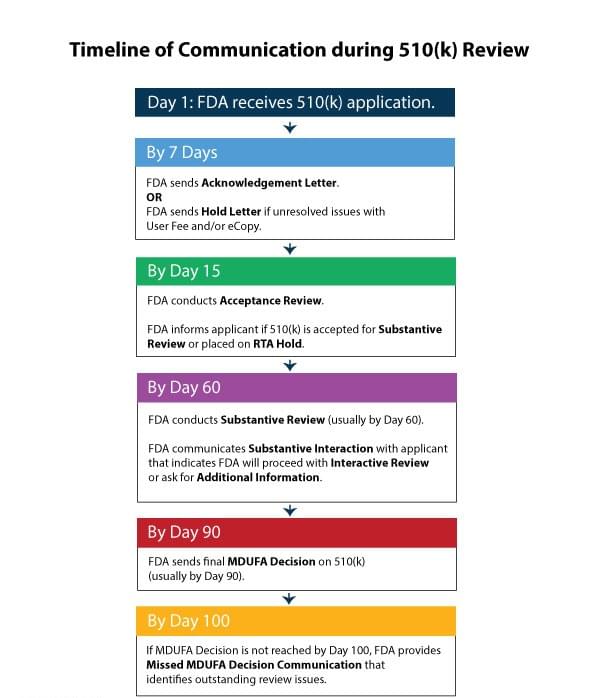
Premarket notification, also called 510(K), is a notification required by the FDA for medical device manufacturers who want to bring their medical devices into the United States.
This notification allows the FDA to assess whether the new device to be marketed is equivalent (indication for use and technical characteristics) to a device that is already currently on the market (predicate device). This evaluation is carried out in order to demonstrate that the new device is as safe and effective as the predicate device.


FDA presents a flowchart that provides a simplified summary of interaction events and milestones during the course of a 510(k) filing. As a general rule of thumb, FDA processing times for a 510(K) premarket notification take around 90 calendar days.
Below is each FDA event/milestone in the processing of a 510(K):

Day on which the FDA receives the application, in this event the FDA does not issue any notification to the applicant.
The FDA acknowledges the information received by the applicant verifying that payment of the corresponding fee and an electronic copy of the 510(K) submission have been received.
This event has two possible outcomes:
• If payment of the applicable fee and electronic copy of the submission are properly received, FDA will email the sender of the 510(k) an Acknowledgment Letter identifying: The date the application was received and the 510(K) number assigned to your filing.
• If payment of the applicable fee and/or electronic copy of the submission is not properly received, FDA will email a Hold Letter to the 510(k) sender, stating the reasons why the file is retained. For this event, the FDA grants 180 calendar days to resolve any problem presented.
FDA assigns a lead reviewer to conduct the Acceptance Review using the appropriate Acceptance Checklist. At the acceptance review, the lead reviewer determines whether the 510(k) submission meets the minimum acceptability threshold and should be accepted for substantive review. Within 15 days of receiving the submission, the submitter will receive an electronic notification of the outcome of the acceptance review, stating:
• The name and contact information of the FDA lead reviewer assigned to the 510(k);
• 510(k) status.
The result of the acceptance review will be one of the following:
• The 510(k) was accepted for substantive review;
• The 510(k) was not accepted for review (ie, considered denied or RTA);
• The 510(k) is under substantive review because the FDA did not complete the acceptance review within 15 calendar days.
For a 510(k) that was not accepted for review (RTA), the submitter will have 180 calendar days to fully address the deficiencies cited in the RTA Suspension
The lead reviewer performs a thorough review of the 510(k) submission and communicates with the submitter through substantive interaction, substantive interaction communication is typically:
• An email stating that FDA will proceed to resolve any outstanding deficiencies through an interactive review;
• An additional information request (AI) that puts the submission on hold.
Interactive review
If the lead reviewer chooses to proceed with an interactive review, it means that any outstanding deficiencies can be appropriately addressed within the time frame set by FDA and will contact the 510(K) submitter via email or phone call.
Additional Information Request (IA)
If the lead reviewer submits a request for additional information, the record is placed on hold and the submitter will have 180 calendar days from the date of the IA Request to submit a full response to the Request.
When a decision is made, the FDA will send the decision letter to the sender by email, indicating whether the device is SE (Substantially Equivalent) or NSE (Not Substantially Equivalent).